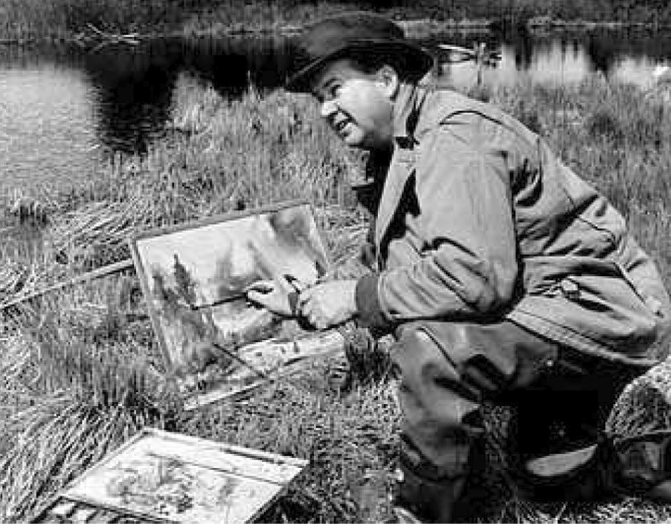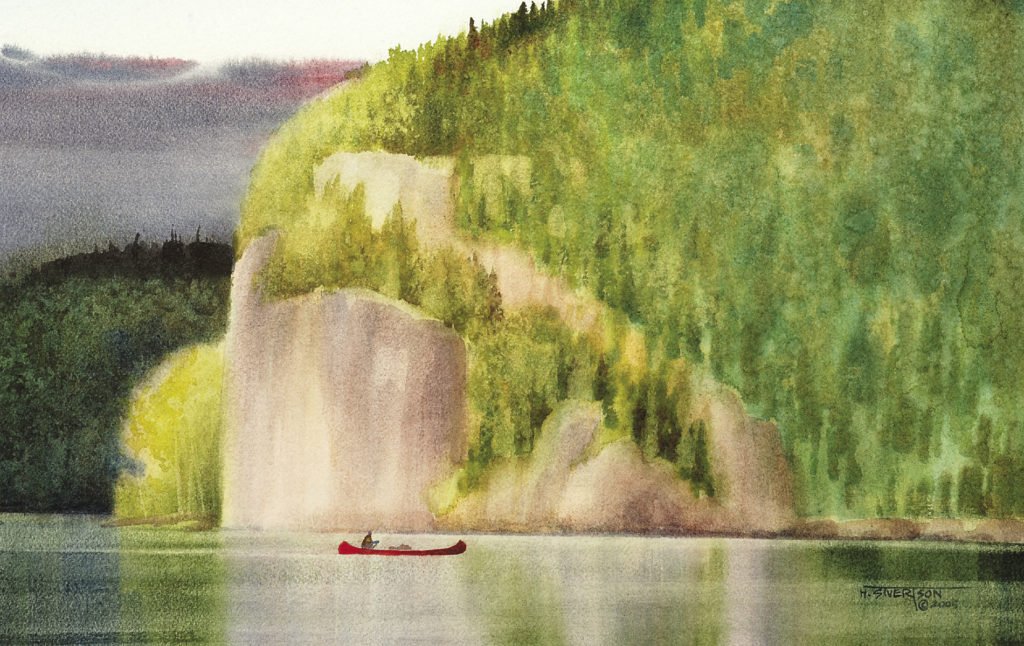It is impossible to ignore art when you are on the North Shore. There is a plethora of galleries, institutions like the Grand Marais Art Colony and the North House Folk School, and a laid-back, creative ambiance that permeates the atmosphere. It’s isn’t unusual to see a plein air painter behind an easel along a Lake Superior beach or to strike up a conversation with someone who turns out to be a carver or a fiber artist. Not only that, but many of the artists who reside here are renowned well beyond this faraway corner of Minnesota.
How did the North Shore become such a hub for artists? It is fair to say the area has attracted artists for more than a century. The Johnson Heritage Post in Grand Marais houses the permanent collection of works by Anna C. Johnson, whose husband operated a trading post on the site in the early 1900s. At mid-century, the Grand Marais Art Colony came to be when, in 1947, Birney Quick began summer workshops for students at the Minneapolis School of Art. Artists were drawn to the beauty of the North Shore and the comradery of working and socializing with other artists.
“The art colony attracts like-minded individuals,” says board co-chair Lynn Speaker. “They are supportive of one another and share ideas.”
Another artistic anchor in the community is the Sivertson Art Gallery, which celebrates its 40th anniversary this year.
“Sivertson Gallery was essential to having art visible in the community,” says Grand Marais artist Betsy Bowen.

Bowen, who has been active with the Art Colony since 1970, believes that having places where creative types can hang out is important to developing an art scene. She remembers a basement pub called the Rathskeller in a place called The Common Ground that drew “Bohemian-type people.” It attracted a different crowd than other local establishments, had live music and was a venue where local art could be shown on the walls.
“It helped foster an arts community,” she says.
For Jan Sivertson, owner of Sivertson Gallery, the North Shore’s draw can be summed up in one word.
“It’s the geography,” she says.
Arts towns often come to be due to a combination of geography and guru, she explains, giving the example of Santa Fe and Georgia O’Keefe. On the North Shore, Birney Quick was the first guru, attracting many talented artists. The North Shore also produced remarkable homespun talent, such as George Morrison and Howard “Bud” Sivertson, for whom Lake Superior was an endless muse. Quick, who died in 1981, invited Hazel Belvo to teach at the Art Colony that year. She then became a driving force for the Art Colony and the local art scene.
“Hazel has drawn more serious artists to the area through her mentorship program with the Grand Marais Art Colony,” Sivertson says.
Tourism promotion and development during recent decades has benefited the arts. Bowen says the shift to an upscale tourist economy and the associated marketing efforts have given the arts a greater presence in the community. New and expanded amenities such as breweries, restaurants and coffee shops add to the creative vibe. She also points out that several new institutions have made a difference, too.
“The Grand Marais Playhouse has been around since the early 1970s,” Bowen says. “The Arrowhead Center for the Arts (where plays are performed) was built in 1997. That showed the arts were important to the community.”
In retrospect, the North Shore’s art scene reached critical mass around the turn of the 21st Century. The local public radio station, WTIP, the North House Folk School, the Solstice Pageant puppet show and the Betsy Bowen Studio all came to be about 20 years ago. In the ensuing two decades, the arts have become a driving force for North Shore tourism. Artists and folks who appreciate the arts often make return visits.
“One of the pleasures of being part of the Grand Marais Art Colony is watching people be introduced to the community and the environment,” says Speaker. “It draws them back. Some have been attending the Art Colony for 20 years.”
This has allowed artists and galleries along the North Shore to thrive. Many of these entrepreneurial enterprises have matured into established businesses.
“If you look at the annual fall gallery tour, most of the participating studios have been around for a while,” says Sivertson.
Making a living as an artist is challenging no matter where you choose to live. A growing number of North Shore artists are making a go of it. It is likely there will be even more self-supporting artists in the future.
As for now, artists, like everyone else, are figuring out how to step forward in a changing world.
“I feel worse for musicians, because what they do is based on get-togethers,” says Bowen. “I think we’ll (artists) figure it out, but it will take a couple of years.”
Artists are able to sell their works online, although it isn’t the same experience for the customer as a gallery or studio visit. In a time of social distancing, the socializing aspect of enjoying art is difficult to achieve. But the very human need for art remains.
“Art will happen anyway,” says Bowen. “You can’t stop it.”

